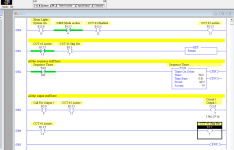TheWaterboy
Lifetime Supporting Member + Moderator
Is there a difference of behavior between the PLC5 and the Logix series when it comes to JSR behavior?
Assuming I do nothing to this bit elsewhere, If I set a bit in a rung that is called by a JSR and then I stop calling the JSR.. what happens to the state of that bit?
I saw this recently in a Logix program and the bit cleared when I stopped calling the JSR. In a PLC5 the bit remains set when I stop calling the JSR.
I would expect the PLC-5 like behavior so the Logix behavior surprised me.
Can anyone confirm this behavior change between platforms or do I need to look harder for some other reason?
Assuming I do nothing to this bit elsewhere, If I set a bit in a rung that is called by a JSR and then I stop calling the JSR.. what happens to the state of that bit?
I saw this recently in a Logix program and the bit cleared when I stopped calling the JSR. In a PLC5 the bit remains set when I stop calling the JSR.
I would expect the PLC-5 like behavior so the Logix behavior surprised me.
Can anyone confirm this behavior change between platforms or do I need to look harder for some other reason?




